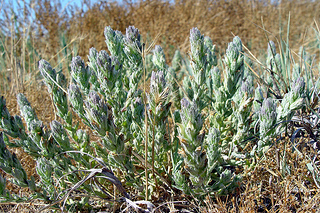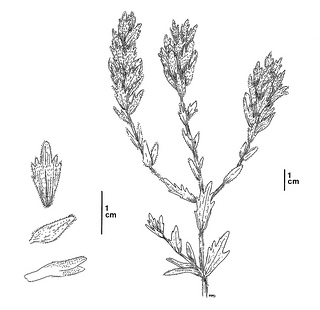(Chloropyron palmatum)
 Chloropyron palmatum. Photo © George Hartwell.
Chloropyron palmatum. Photo © George Hartwell.
 Chloropyron palmatum. CDFW illustration by Mary Ann Showers. (Click to enlarge)
Chloropyron palmatum. CDFW illustration by Mary Ann Showers. (Click to enlarge)
Palmate salty bird’s-beak (or palmate-bracted bird’s-beak) is a California endangered plant species, which means that killing or possessing this plant is prohibited by the California Endangered Species Act (CESA). This species is also listed as endangered under the federal Endangered Species Act. Palmate salty bird’s-beak is an annual herb in the broomrape family (Orobanchaceae), and grows to 12 inches tall. It is branched from the base and covered with short glandular hairs that excrete salt crystals, giving the plant its pale gray-green appearance. Flowers, which are nearly hidden in green to lavender bracts, are whitish in color and often pale lavender on the sides. Palmate salty bird’s-beak is hemiparasitic, meaning that it manufactures its own food but obtains additional water and nutrients from the roots of other (host) plants, such as saltgrass (Distichlis spicata). Palmate salty bird’s-beak flowers from late spring through summer.
Palmate salty bird’s-beak grows in saline-alkaline soils in seasonally-flooded lowland plains and basins at elevations of less than 500 feet. Associated plant species include iodine bush (Allenrolfea occidentalis), alkali heath (Frankenia salina), Great Valley gum plant (Grindelia camporum), and Parry’s rough tarplant (Centromadia parryi ssp.rudis).Historically, this species is known from scattered locations in Fresno and Madera counties in the San Joaquin Valley, San Joaquin, Yolo, and Colusa counties in the Sacramento Valley, and the Livermore Valley area of Alameda County. At the time of this webpage posting, the California Natural Diversity Database reports 14 natural occurrences and 4 introduced occurrences that are presumed to exist. Existing occurrences are located on the Sacramento National Wildlife Refuge (NWR) in Glenn County, at Delavan NWR and Colusa NWR in Colusa County, at Alkali Grasslands Preserve in Woodland, at Springtown Alkali Sink near Livermore, in western Madera County, and at the combined Alkali Sink Ecological Reserve and Mendota Wildlife Management Area in Fresno County. All of the occurrences on the Sacramento NWR are introduced populations.
The primary threats to palmate salty bird’s-beak include habitat alteration due to urban development and agricultural practices, and encroachment of non-native exotic plant species such as perennial pepperweed (Lepidium latifolium)into existing populations. Other threats to this species include changes in hydrology, road maintenance, unauthorized fill of wetlands, off-road vehicle use, and climate change.
One of the most important goals for the conservation of palmate salty bird’s-beak is the protection of occupied habitat on private lands. A comprehensive research and management plan should be developed, and it should include an evaluation of habitat management tools (e.g., burning, grazing, and herbicides) as well as an evaluation of re-introduction methods. Basic biological research should be conducted to study the importance of periodic flooding to seed dispersal and the negative effects of invasions by non-native plants.
CDFW has participated in the following palmate salty bird’s-beak studies and projects with support from the Cooperative Endangered Species Conservation Fund, the California Endangered Species Tax Check-off Funds, or other mechanisms:
CDFW may issue permits for palmate salty bird’s-beak pursuant to CESA, and you can learn more about the California laws protecting palmate salty bird’s-beak and other California native plants. Populations of palmate salty bird’s-beak occur in CDFW’s North Central Region, Bay Delta Region, and Central Region. More information is also available from the U.S. Fish and Wildlife Service Species Profile for Palmate Salty Bird’s-Beak.
Updated 06/14/2023